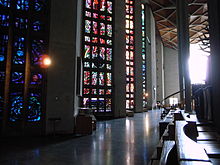Lawrence Lee
| Lawrence Lee | |
|---|---|

Lee's windows in the Nave of Coventry Cathedral
|
|
| Born |
Lawrence Stanley Lee September 18, 1909 Chelsea, London |
| Died | April 25, 2011 (aged 101) |
| Nationality | British |
| Education |
Kingston School of Art, Royal College of Art |
| Known for | stained glass, painting, drawing |
| Notable work | Windows in Coventry Cathedral, Southwark Cathedral and Guildford Cathedral |
| Movement | modern art |
| Spouse(s) | Dorothy Tucker |
| Elected | Master of the Worshipful Company of Glaziers, 1976. |
Lawrence Stanley Lee (18 September 1909 – 25 April 2011) was a British stained glass artist whose work spanned the latter half of the 20th century. He was best known for leading the project to create ten huge windows for the nave of the new Coventry Cathedral. His other work includes windows at Guildford and Southwark Cathedrals as well as a great number of works elsewhere in the UK, and some in Canada, Australia and New Zealand.
Lee was born in Chelsea Hospital for Women on 18 September 1909. His family moved to Weybridge where his father, William, a chauffeur and engineer, had a garage near to the Booklands Race Track. Lawrence's mother, Rose, was deeply religious and it was this influence that gave him the appreciation of biblical symbolism that became an important feature of his work. His parents divorced and Lawrence moved with his mother to New Malden. At the local Methodist church he met Dorothy Tucker, later to become his wife.
He left school at 14, but won a scholarship to Kingston School of Art. A further award in 1927 enabled him to attend the Royal College of Art, where he studied stained glass under Martin Travers, graduating in 1930.
Lee's first job was as an assistant to Travers in his studio. For a while he joined James and Lilian Dring in an artistic co-operative. His works included a range of craft and art work produced at Southside Studios in Clapham, London. He also worked part-time teaching at Kingston and Bromley schools of art.
For a year prior to the outbreak of war, Lee joined the Anglican Franciscan Friary at Cerne Abbey, Dorset, but at the outbreak of war, abandoned monastic life to fight fascism.
In the summer of 1940, Lee married Dorothy Tucker. Lee joined the Royal Army Medical Corps but transferred to the Royal Artillery, serving as an anti-aircraft gunner for a while. He was promoted from cadet to Second Lieutenant in June 1942. He subsequently served in North Africa and Italy, seeing action at the battle of the Kasserine Pass in Tunisia in February 1943 and in the Allied landings at Salerno later that year. He was transferred to the Army Educational Service in Italy in February 1945, maintaining his rank of Lieutenant, and ran courses in art and culture. He sketched and painted throughout the war, capturing an eruption of Mount Vesuvius whilst in Italy. The Imperial War Museum holds five watercolours of tanks and desert scenes, and, though some works were declined in 1942, a donation from James Dring was accepted and further works were subsequently purchased. Other work from this period is held in the Ashmolean Museum.
...
Wikipedia
